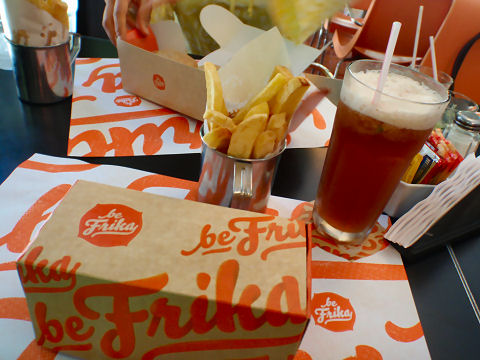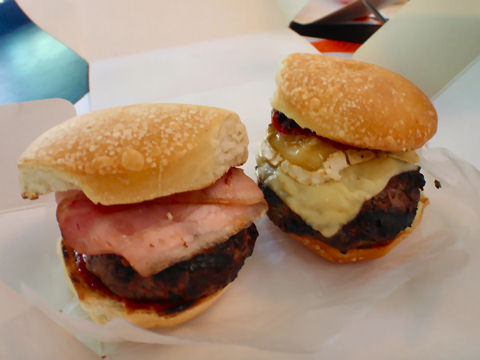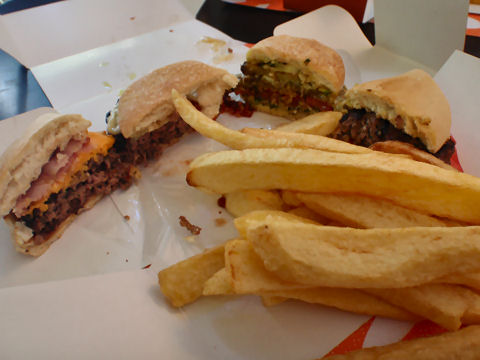Harold: I want 30 sliders, 5 french fries, and 4 large cherry cokes.
Kumar: I want the same except make mine diet cokes.
– from Harold & Kumar go to White Castle
While White Castle may not have invented the hamburger, and in fact that tasty treat’s origins are a matter of some dispute, there are a couple of things that this Wichita, Kansas upstart can be credited with. In 1916, one Walter Anderson, a fry cook at a local spot, invented the first hamburger bun. In 1921, nearly 20 years before Ray Kroc and McDonald’s, he and his co-founders launched the original White Castle, which grew over the years to fewer than 300 locations, most of them east of the Mississippi. In the early days, they were very tightly controlled – they had their own processing facilities, bakeries, etc. – as noted in their official history, the only thing they didn’t do was raise their own cattle and wheat. The early burgers were all made from freshly ground beef and chopped onions, a ball of beef with onions pressed into the top, grilled first on the bottom, then flipped and flattened to that the onions caramelized and imparted flavor to the patty. It wasn’t until the mid-30s that the slyder or slider came into being – when the company was bought out, contracted with Swift to supply frozen pre-shaped patties and dehydrated onions. The cooking process had to change and the unique (and questionable) “steam grilling” process came into being, allowing the onions to rehydrate on the bottom from moment one, and the steam cooking the burger (which later had holes punched through it to facilitate the steam’s passage). One could also credit them for creating the first mini-burgers, the first fast-food chain, and, the now ubiquitous paper hats that every fast food chain seems to have embraced.
So what does this little history lesson have to do with anything? Easy, the introduction of the first mini-burgers to Buenos Aires, in imitation fast-food form – i.e., they’re not fast food, they’re cooked from fresh beef (and other options), to order, in a restaurant, though they’re packaged as if they’re fast food. Sort of.

Enter
BeFrika,
corner of Junín and French, a mere two blocks from my house, in the space that until recently was a little music cafe called Shemesh, and prior to that, for many years, a local expat hangout called, if I remember right, Blue & Grey Cafe, (closed, but new location opened at Larrea 1535, Recoleta). Despite the restaurant’s Belgian URL for its website, it does not seem to be a local branch of some ubiquitous Belgian chain of mini-burger restaurants. The
frika has a couple of possible origins – it is the Danish word for a large meatball, that some say is the precursor to the hamburger, it is also the slang in Dutch and German for a
frikandel, a sausage of sorts, or, perhaps, a currywurst plate. The Belgian connection does show up in the fries, which are thick cut, perfectly cooked, and served in a cup – very much the style from one of those Belgian fry places that have popped up all over the U.S. in recent years – one warning, they salt their fries as they come out of the fryer, unlike the local standard of leaving it to the customer to do so.

Opening up your little fast food box reveals two mini-burgers of your choice – in general, a pair of them runs about 20 pesos, and you can have two of the same or mix and match to your heart’s content. Here, the “Frankie & Johnny”, a bacon-cheddar burger with a passable bbq sauce, and the French-styled brie and tomato confit version. One of our first thoughts was, given that the burgers are transported a mere 3-4 meters from kitchen to table, the whole box process seems both a waste of time and the amount of cardboard a huge environmental no-no – turns out that on request they’ll serve your burgers on a plate, no problem. Burgers can also be cooked to order, though the standard, if you don’t specify, is well-done.

Between us we’d ordered four different kinds – the two mentioned above, plus we thought we’d try the veggie burger – tasty, but more grilled veggies on the bun than the burger itself, which was a wafer thin soy patty that did little more than add some crunch – and a “Speddy Gonzalez”
[sic], which was purported to have guacamole and Mexican salsa on it – the former showing up as a faint green smear on the bun and the latter being nothing more than chopped tomato and onion – our least favorite of the four burgers. No question our favorite was the bacon-cheddar burger, and both the fries and the unsweetened (!!!) iced tea were absolute winners. Being a mere two blocks from home, and having free wi-fi, they’re likely to become a hangout for my writing days, iced teas at the ready.
[Edit: About a year after this review, BeFrika altered their menu and started offering all burgers in both minis (90gm) as well as “bigger”, 160gm burgers.]








We are burger hounds over here… what a great idea! And thank you for the quote from and link to “Will chocolate buttons taste like shit?” Love it.
This sounds like a fantastic little spot. I adore White Castel burgers and know I’d like this place. Be careful, Dan, not to find too many excuses to end up there too frequently.
AWESOME!!!!! IT FEELS LIKE HOME !!!!!! ALTHOUGH “WHITE CASTLE” BURGERS (in my opinion), are a bunch of YUCK 🙁 , the fact that ARGENTINE BEEF is the star here, and a part of what makes us love the food in Argentina, it makes this place SOOOOOOOOO WORTH GOING, AND GOING, AND GOING BACK AGAIN.
[…] to the sandwich, and perhaps some crunch. Even those places that gussy them up a bit, like, say Befrika, can’t disguise the fact that the “burger” is not the star player on the plate. […]
[…] the first time I tried the veggie burger at BeFrika, I was unimpressed. And apparently numerous people were, as they’ve completely redone it, and […]